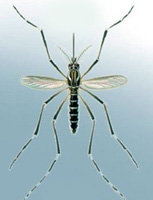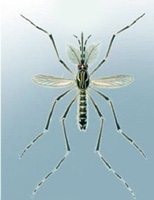Tick and Mites
1. Ticks are arthropods (invertebrates with external skeletons and jointed legs), but they’re neither insects nor spiders. Ticks belong to a special group of mites; all ticks are mites, but not all mites are ticks. The term ‘tick’ is also used botanically to describe certain kinds of plants (such as Tick Trefoil and Beggar’s Ticks) and their seeds that are adapted to adhering to animal fir (and our clothing).
2. All ticks are external parasites. The tick, itself, cannot burrow into the skin. Instead, only their mouth part actually enter the skin. Ticks require a blood meal to develop and to produce eggs. They feed on nothing else but blood.
3. Many have evolved a close ecological association with, and dependence on, their normal hosts and may not even feed upon other kinds of animals if given the opportunity.
How Ticks can spread disease?
Ticks transmit pathogens that cause disease through the process of feeding.
- Depending on the tick species and its stage of life, preparing to feed can take from 10 minutes to 2 hours. When the tick finds a feeding spot, it grasps the skin and cuts into the surface.
- The tick then inserts its feeding tube. Many species also secrete a cement-like substance that keeps them firmly attached during the meal. The feeding tube can have barbs which help keep the tick in place.
- Ticks also can secrete small amounts of saliva with anesthetic properties so that the animal or person can't feel that the tick has attached itself. If the tick is in a sheltered spot, it can go unnoticed.
- A tick will suck the blood slowly for several days. If the host animal has a bloodborne infection, the tick will ingest the pathogens with the blood.
- Small amounts of saliva from the tick may also enter the skin of the host animal during the feeding process. If the tick contains a pathogen, the organism may be transmitted to the host animal in this way.
- After feeding, most ticks will drop off and prepare for the next life stage. At its next feeding, it can then transmit an acquired disease to the new host.
How Ticks find their host?
- Ticks find their hosts by detecting animals´ breath and body odors, or by sensing body heat, moisture, and vibrations. Some species can even recognize a shadow. In addition, ticks pick a place to wait by identifying well-used paths. Then they wait for a host, resting on the tips of grasses and shrubs. Ticks can't fly or jump, but many tick species wait in a position known as "questing".
- While questing, ticks hold onto leaves and grass by their third and fourth pair of legs. They hold the first pair of legs outstretched, waiting to climb on to the host. When a host brushes the spot where a tick is waiting, it quickly climbs aboard. Some ticks will attach quickly and others will wander, looking for places like the ear, or other areas where the skin is thinner.
How Ticks survive?
1. Have four life stages.
2. After hatching from the eggs, ticks must eat blood at every stage to survive.
3. Ticks that require this many hosts can take up to 3 years to complete their full life cycle,
and most will die because they don't find a host for their next feeding.
and most will die because they don't find a host for their next feeding.

Relative sizes of several ticks at different life stages.

Ticks can feed on mammals, birds, reptiles, and amphibians. Most ticks prefer to have a different host animal at each stage of their life,

Disease that carry by Ticks
- Anaplasmosis is transmitted to humans by tick bites primarily from the blacklegged tick (Ixodes scapularis) in the northeastern and upper midwestern U.S. and the western blacklegged tick (Ixodes pacificus) along the Pacific coast.
- Babesiosis is caused by microscopic parasites that infect red blood cells. Most human cases of babesiosis in the U.S. are caused by Babesia microti. Babesia microti is transmitted by the blacklegged tick (Ixodes scapularis) and is found primarily in the northeast and upper midwest.
- Borrelia miyamotoi infection has recently been described as a cause of illness in the U.S. It is transmitted by the blacklegged tick (Ixodes scapularis) and has a range similar to that of Lyme disease.
- Colorado tick fever is caused by a virus transmitted by the Rocky Mountain wood tick (Dermacentor andersoni). It occurs in the the Rocky Mountain states at elevations of 4,000 to 10,500 feet.
- Ehrlichiosis is transmitted to humans by the lone star tick (Ambylomma americanum), found primarily in the southcentral and eastern U.S.
- Heartland virus infection has been identified in eight patients in Missouri and Tennessee as of March 2014. Studies suggest that Lone Star ticks may transmit the virus. It is unknown if the virus may be found in other areas of the U.S.
- Lyme disease is transmitted by the blacklegged tick (Ixodes scapularis) in the northeastern U.S. and upper midwestern U.S. and the western blacklegged tick (Ixodes pacificus) along the Pacific coast.
How to Control??
. The infested house and/or kennel should be thoroughly cleaned in order to eliminate as many ticks as possible. Vacuuming is very helpful inside. Pet bedding and pet areas should be cleaned well.
2. Kennels, dog houses, and structures occupied by pets should be thoroughly treated to control ticks that have dropped off the dog and that reside in harborage areas.
Residual insecticide sprays and dusts should be applied carefully to all potential tick harborage areas.
Residual insecticide sprays and dusts should be applied carefully to all potential tick harborage areas.
3.Ticks like to reside in the upper portions of structures in cracks and crevices and the areas used by dogs.
Recommended residual insecticides inside would be Bifen IT or Conquer.
4.Non residual space sprays that contain Pyrethrins such as CB 80 may be useful to supplement the residual sprays. It may used on a daily basis and is a contact killer.
5.Control domestic animal (host)
MITES
1.Mites are tiny arthropods, related to ticks. Several types of mites can be found in homes and of these a few may bite humans. Most mites are harmless predators of insects, or feeders on decaying plant material.
2. Some pest mites feed on stored products like cheese and grain. Others are merely nuisance pests, accidentally entering homes from their normal outdoor habitat.
3. Only a few mite species are parasitic on birds or mammals, but these can occasionally become biting pests in homes.
4. Identifying the type of mite and/or likely host is the first step in solving an indoor mite infestation.
5.Mites are small arthropods belonging to the subclass Acari (also known as Acarina) and the class Arachnida.
Life cycle of Mites..

Disease that carry by Mites..
1. scrub typhus
2. rickettsial
How to prevent?
1.Avoid poor hygiene
2.Pesticides for outdoor residual treatment
3.Keeping grasses cut short and removing vegetable near buildings.
4.Repellent
ENJOY THE VIDEO :))





